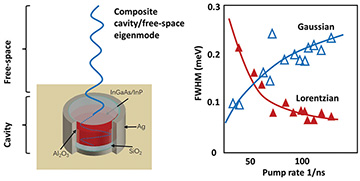 Left: Schematic view of a metallic-nanocavity laser. Right: Pump-rate dependence of the emission linewidth, with a dominating Gaussian part at high excitation. [Enlarge figure]
Left: Schematic view of a metallic-nanocavity laser. Right: Pump-rate dependence of the emission linewidth, with a dominating Gaussian part at high excitation. [Enlarge figure]
Optoelectronics is at an exciting period, with intense activity driven by applications ranging from telecommunications and room lighting to the internet and quantum information processing. Significant advances have been made and reported on in laser performance, including reduced footprint, decreased energy requirements, improved spectral stability and nonclassical photon statistics—all of which increase the role of quantum optics.1 The quantum-mechanical aspect of radiation can develop new capabilities (such as single and entangled photons) and explain improved device performance, especially for setups approaching fundamental limits.
Recently, our six-institute collaboration has investigated cavity quantum electrodynamics (CQED) effects on the fundamental limits on intensity and frequency stability in semiconductor lasers. The goal has been to understand the influences of quantum fluctuations on device performance. The work involved performing optical and quantum-optical experiments on quantum-well metallic-nanocavity lasers with ultra-high spontaneous emission factor (β) to explore the underlying photon statistics.
Concurrently, we performed CQED calculations where spontaneous emission via radiation field quantization was the only contribution to photon statistics and laser field phase diffusion, and compared the calculations with experimental results with respect to input-output characteristics, coherence time and second-order photon-autocorrelation function. Good agreement between theory and experiment on all three quantities confirmed that our devices operate in the fundamental limit governed by quantum-optical effects.2,3
Importantly, our work addresses the long- standing lasing lineshape anomaly—specifically, the intriguing, excitation-power-dependent deviation from the CQED-predicted Lorentzian lineshape. To study the underlying physics, we used an advanced composite-mode theory, considering interacting laser-cavity and free-space modes. We arrived at the important conclusion that an intrinsic contribution arises from the intricate interplay between cavity outcoupling and the nonlinear complex susceptibility from the active medium. While extrinsic contributions may exist, we found that they only add to the always-present intrinsic contribution we discovered in this work.3
The experimental and theoretical techniques developed in our studies apply not only to emerging nanolasers, but to other semiconductor laser systems as well, such as ultranarrow-linewidth, heterogeneously integrated III–V/Si lasers.4
Researchers
Aris Koulas-Simos, Georgios Sinatkas and Stephan Reitzenstein, Technische Universität Berlin, Berlin, Germany
Joel Buchgeister, Monty L. Drechsler, Frederik Lohof, Frank Jahnke and Christopher Gies, Universität Bremen, Bremen, Germany
Taiping Zhang and Jialu Xu, Tsinghua University, Beijing, China
Cun-Zheng Ning, Shenzhen Technology University, Shenzhen, China
Kaisa Laiho, German Aerospace Center, Ulm, Germany
Qiang Kan and Ruikang K. Zhang, Chinese Academy of Sciences, Beijing, China
Weng W. Chow, Sandia National Laboratories, Albuquerque, NM, USA
References
1. W.W. Chow and S. Reitzenstein. Appl. Phys. Rev. 5, 041302 (2018).
2. S. Kreinberg et al. Light Sci. Appl. 6, e17030 (2017).
3. A. Koulas-Simos et al. Laser Photon. Rev. 16, 2200086 (2022).
4. W.W. Chow et al. Laser Photon. Rev. 16, 2100620 (2022).
